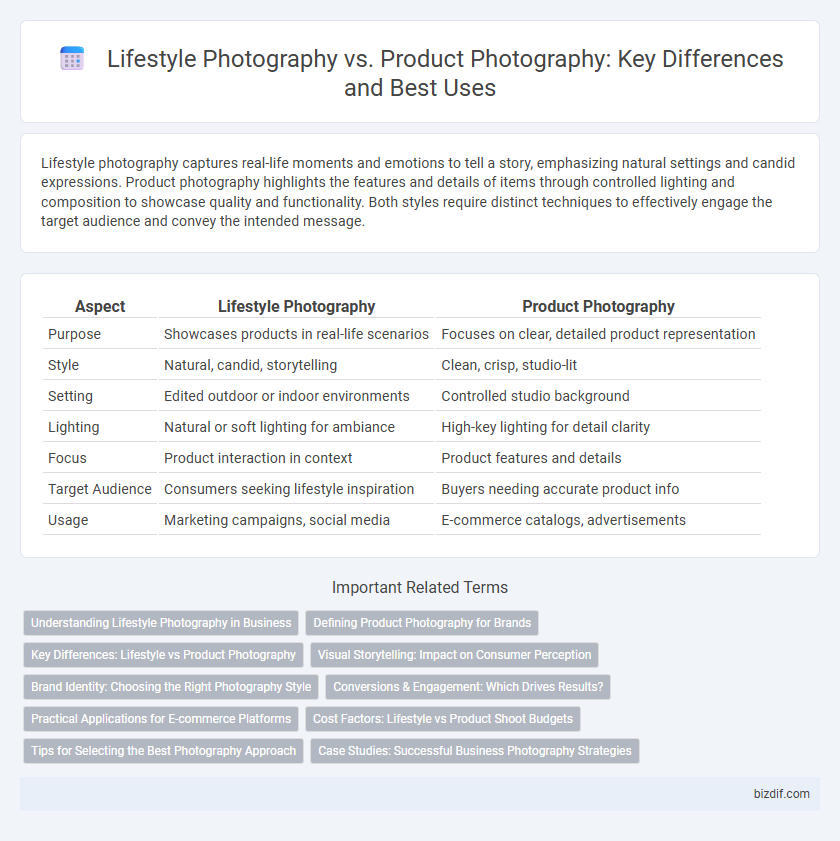Lifestyle photography captures real-life moments and emotions to tell a story, emphasizing natural settings and candid expressions. Product photography highlights the features and details of items through controlled lighting and composition to showcase quality and functionality. Both styles require distinct techniques to effectively engage the target audience and convey the intended message.
Table of Comparison
| Aspect | Lifestyle Photography | Product Photography |
|---|---|---|
| Purpose | Showcases products in real-life scenarios | Focuses on clear, detailed product representation |
| Style | Natural, candid, storytelling | Clean, crisp, studio-lit |
| Setting | Edited outdoor or indoor environments | Controlled studio background |
| Lighting | Natural or soft lighting for ambiance | High-key lighting for detail clarity |
| Focus | Product interaction in context | Product features and details |
| Target Audience | Consumers seeking lifestyle inspiration | Buyers needing accurate product info |
| Usage | Marketing campaigns, social media | E-commerce catalogs, advertisements |
Understanding Lifestyle Photography in Business
Lifestyle photography captures real-life situations, emotions, and interactions, creating authentic and relatable images that resonate with target audiences. It enhances brand storytelling by showcasing products or services within everyday contexts, driving customer engagement through emotional connection. Businesses leverage lifestyle photography to build trust and convey value, differentiating themselves in competitive markets.
Defining Product Photography for Brands
Product photography for brands focuses on capturing high-quality images that highlight the features, details, and unique selling points of products to attract potential customers. It emphasizes precise lighting, clean backgrounds, and accurate color representation to ensure the product looks appealing and true to life. Effective product photography enhances brand identity by visually communicating value and quality across e-commerce platforms and marketing materials.
Key Differences: Lifestyle vs Product Photography
Lifestyle photography captures people in real-life situations to convey emotions and tell stories, emphasizing natural settings and candid moments. Product photography focuses on showcasing items with clear, high-quality images that highlight details, features, and brand aesthetics in controlled studio environments. Key differences lie in the purpose: lifestyle photography aims to create emotional connections, while product photography prioritizes visual clarity and appeal for marketing and e-commerce.
Visual Storytelling: Impact on Consumer Perception
Lifestyle photography captures authentic moments that evoke emotions and create relatable narratives, enhancing consumer connection with the brand. Product photography emphasizes clarity and detail, showcasing features to inform and persuade potential buyers. Visual storytelling in lifestyle photography influences consumer perception by building trust and aspirational value, while product photography drives purchasing decisions through precision and focus.
Brand Identity: Choosing the Right Photography Style
Lifestyle photography captures authentic moments that convey a brand's personality and values, fostering emotional connections with the audience. Product photography emphasizes clarity and detail, highlighting features to build trust and showcase quality. Selecting the appropriate style aligns visual content with brand identity, enhancing recognition and customer engagement.
Conversions & Engagement: Which Drives Results?
Lifestyle photography enhances conversions by creating emotional connections that engage audiences through authentic storytelling, making products feel relatable and desirable. Product photography drives results by showcasing clear, detailed images that highlight features and benefits, building consumer trust and facilitating informed purchasing decisions. Combining both approaches strategically maximizes engagement and boosts overall sales performance.
Practical Applications for E-commerce Platforms
Lifestyle photography enhances e-commerce platforms by showcasing products within real-life scenarios, creating emotional connections that boost customer engagement and conversion rates. Product photography focuses on clear, detailed images of items, emphasizing features and quality to facilitate informed purchasing decisions. Combining both styles leverages visual storytelling and precise product representation, optimizing user experience and increasing sales on online marketplaces.
Cost Factors: Lifestyle vs Product Shoot Budgets
Lifestyle photography budgets typically include higher costs due to location fees, model fees, and styling expenses, reflecting the need for authentic settings and real-life scenarios. Product photography budgets are often lower, focusing on studio rental, equipment, and post-production to highlight item details with controlled lighting. Choosing between lifestyle and product shoots depends on how much brands allocate to contextual storytelling versus pure product visibility in their marketing strategy.
Tips for Selecting the Best Photography Approach
Selecting the best photography approach depends on the intended purpose: lifestyle photography emphasizes authentic moments and emotional connection, making it ideal for brand storytelling, while product photography focuses on clarity and detail to highlight features and enhance online sales. Prioritize natural lighting and candid shots for lifestyle images, whereas controlled lighting and clean backgrounds are essential for product photos to ensure crisp, professional presentation. Consider the target audience's preferences and the marketing platform to determine whether a narrative-driven or a detail-oriented style will yield greater engagement and conversion.
Case Studies: Successful Business Photography Strategies
Case studies highlight how lifestyle photography enhances brand storytelling by showcasing products in real-life contexts, boosting customer engagement and conversion rates. Product photography, focused on clear, high-quality images, drives sales through detailed visual information that builds consumer trust. Businesses integrating both strategies report stronger market presence and increased ROI by appealing to diverse consumer preferences.
Lifestyle Photography vs Product Photography Infographic

 bizdif.com
bizdif.com